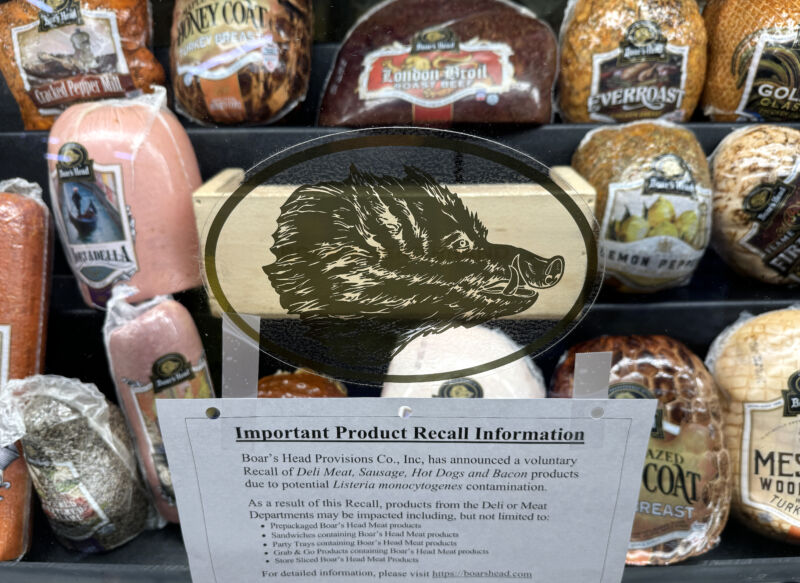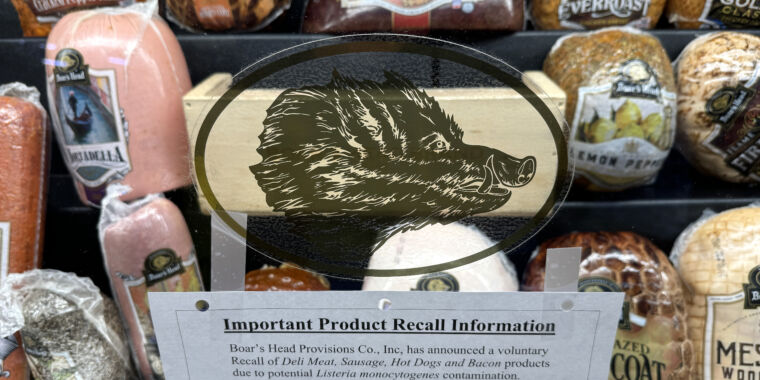Blood puddles, mold, tainted meat, bugs: Boar’s Head inspections are horrifying
“ample amounts of blood” —
The USDA recorded 69 violations in a year. So far, 9 people have died in the outbreak.

Enlarge / A recall notice is posted next to Boar’s Head meats that are displayed at a Safeway store on July 31, 2024, in San Rafael, California.
Federal inspections found 69 violations—many grisly—at the Boar’s Head meat facility at the center of a deadly, nationwide Listeria outbreak that has now killed nine people, sickened and hospitalized a total of 57 across 18 states, and spurred the nationwide recall of more than 7 million pounds of meat.
The Jarratt, Virginia-based facility had repeated problems with mold, water leaks, dirty equipment and rooms, meat debris stuck on walls and equipment, various bugs, and, at one point, puddles of blood on the floor, according to inspection reports from the US Department of Agriculture’s Food Safety and Inspection Services. The reports were obtained by CBS News through a Freedom of Information Act Request. In all, the reports outline 69 violations just between the dates of August 1, 2023, and August 2, 2024.
The findings in the reports reveal the perfect conditions for the company’s meat to become contaminated with the germ behind the deadly outbreak, Listeria monocytogenes. This is a hardy germ that is ubiquitous in the environment, including in soil and water, and it spreads among people via the fecal-oral route. In healthy people, it usually only causes gastrointestinal infections. But for older people, newborns, and the immunocompromised, it can cause a life-threatening invasive infection with a fatality rate of around 17 percent. It’s also a significant danger to pregnant people, causing miscarriage, stillbirth, premature delivery, and life-threatening infections in newborns.
While it’s always lurking, L. monocytogenes especially plagues the food industry because it has the notable ability to reproduce at refrigerator temperatures—a condition that typically limits the growth of other nasty germs.
Buildup and bugs
In the Boar’s Head facility, L. monocytogenes appeared to have various opportunities to beef up its numbers. For one, the facility had a long track record of trash and meat debris in various places, which was sometimes reported alongside insect sightings. For instance, on June 10, an inspector entered the “pickle vat pump room” and noted “heavy meat buildup” on the walls, which were also crawling with flies and gnats. On the same day, an inspection of a different area found a rollup door with meat buildup on it, and a water pipe over the door leaked a steady stream of water down the wall and onto the floor. There was also a “steady line of ants” and an inventory of ladybugs, a cockroach, and a beetle of some sort. Earlier, on March 13, an inspection of a room next to where netted hams were handled, an inspector found trash and meat protein on the floor, including “whole pork muscles.”
Going back to August 8, 2023, an inspection likewise found processing lines covered in meat particles and trash. “Heavy discolored meat buildup” was found covering a hydraulic pump, and pieces of meat and fat clung to the support braces of a catwalk. An inspection-line scale had meat pieces and trash in it—and it smelled bad. “Multiple instances of meat were found around the department on the floor. As well as standing water containing a brown mud/dirt-like substance,” the inspection read.
The facility had numerous problems with water leaks and condensation, which fits with the other numerous sightings of mold. The facility temporarily fixed water pipe leaks by wrapping the pipes in plastic. On October 26, an inspector noticed a plastic-wrapped pipe in the cure cooler. The plastic was dated August 17, and there was “orange/brown water pooled in the lowest hanging point.”
Bubbles and blood
On January 9, the inspection of a holding cooler found spots of black mold as large as a quarter throughout the room. On July 23, an inspector noticed bubbled paint on the wall around employee hand-washing sinks. The bubbles were filled with water. And under the sinks, the inspector found black mold and pink mildew.
On July 17, the inspector found “green algal growth” in a puddle of standing water in a raw holding cooler. And on July 27, an inspector noted clear liquid leaking out from a square patch on the ceiling. Behind the patch, there were two other patches that were also leaking. An employee came and wiped the liquid away with a sponge, but it returned within 10 seconds. The employee wiped it again, and the liquid again returned within 10 seconds. Meanwhile, a ceiling fan mounted close by was blowing the leaking liquid onto uncovered hams in a hallway outside the room.
To top if off, a report on February 21 found a raw cooler with “ample amounts of blood in puddles on the floor” and a “rancid smell.”
According to USDA documents, the agency has not taken enforcement actions against Boar’s Head, and there is no data available on swab testing for Listeria at the Virginia facility. The plant has been shut down since late July after health investigators found the outbreak strain of L. monocytogenes in unopened containers of Boar’s Head liverwurst.
In a statement updated on August 29, Boar’s Head said, “We are conducting an extensive investigation, working closely with the USDA and government regulatory agencies, as well as with the industry’s leading food safety experts, to determine how our liverwurst produced at our Jarratt, Virginia facility was adulterated and to prevent it from happening again… We will not resume operations at this facility until we are confident that it meets USDA regulatory standards and Boar’s Head’s highest quality and safety standards.”
Blood puddles, mold, tainted meat, bugs: Boar’s Head inspections are horrifying Read More »
